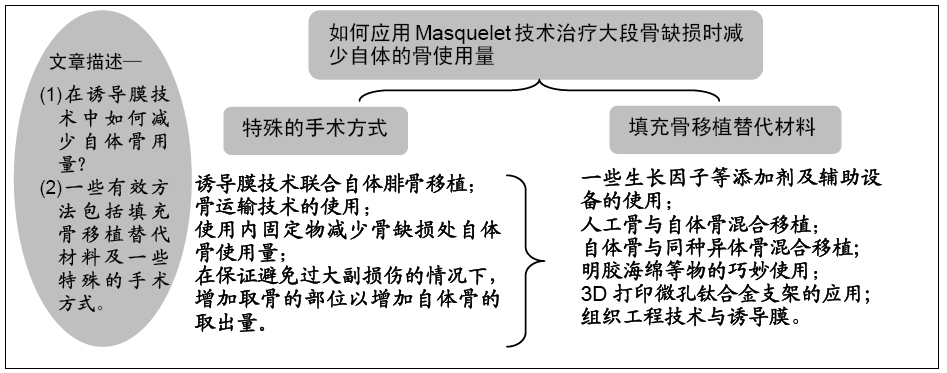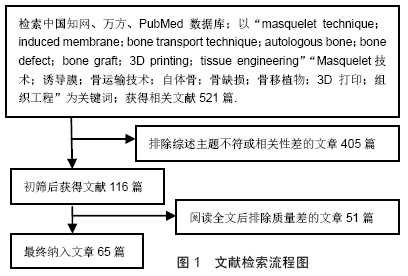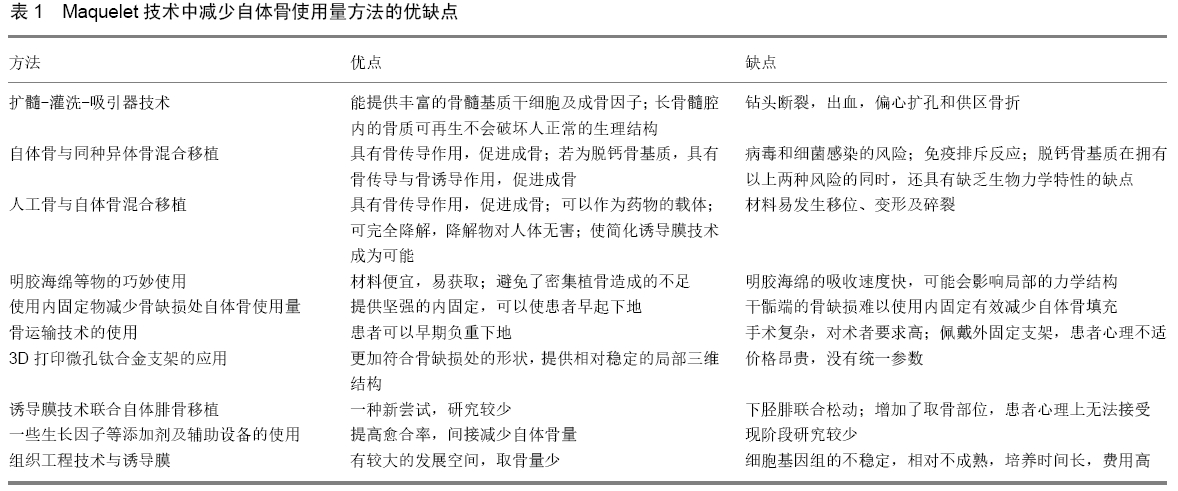[1] MASQUELET AC, FITOUSSI F, BEGUE T, et al. Reconstruction of the long bones by the induced membrane and spongy autograft.Ann Chir Plast Esthet.2000;45(3):346-353.
[2] HUANG K, FEI L, HOU TY, et al. The Role of Induced Membrane in Bone Defect.J Biomater Tissue Eng.2015;5(9):680-686.
[3] MORELLI I, DRAGO L, GEORGE DA, et al. Masquelet technique: myth or reality? A systematic review and meta-analysis.Injury. 2016; 47(6):S68-S76.
[4] 谢肇,喻胜鹏.膜诱导技术治疗感染性骨不连、骨缺损[J].中华骨科杂志, 2018,38(9):570-576.
[5] CONWAY JD. Autograft and nonunions: morbidity with intramedullary bone graft versus iliac crest bone graft.Orthop Clin North Am. 2010; 41(1):75-84.
[6] SAGI HC, YOUNG ML, GERSTENFELD L, et al. Qualitative and quantitative differences between bone graft obtained from the medullary canal (with a Reamer/Irrigator/Aspirator) and the iliac crest of the same patient.J Bone Joint Surg Am.2012;94(23):2128-2135.
[7] MASQUELET AC, BEGUE T. The concept of induced membrane for reconstruction of long bone defects.Orthop Clin North Am. 2010;41(1): 27-37.
[8] COX G, JONES E, MCGONAGLE D, et al. Reamer-irrigator-aspirator indications and clinical results: a systematic review.Int Orthop. 2011; 35(7):951-956.
[9] 李海峰,顾三军,殷渠东.扩髓-灌洗-吸引器的研究现状与应用特点[J].中国组织工程研究,2018,22(14):2284-2289
[10] DAWSON J, KINER D, GARDNER W, et al. The reamer-irrigator- aspirator as a device for harvesting bone graft compared with iliac crest bone graft: union rates and complications.J Orthop Trauma. 2014;28(10):584-590.
[11] DEHGHAN N, SCHEMITSCH EH. Extended applications of the reamer-irrigator-aspirator (RIA) system.Injury.2017;48 (Suppl 1):47-51.
[12] MARCHAND LS, ROTHBERG DL, KUBIAK EN, et al. Is This Autograft Worth It?: The Blood Loss and Transfusion Rates Associated With Reamer Irrigator Aspirator Bone Graft Harvest.J Orthop Trauma. 2017; 31(4):205-209.
[13] MADISON RD, NOWOTARSKI PJ. The Reamer-Irrigator-Aspirator in Nonunion Surgery.Orthop Clin North Am.2019;50(3):297-304.
[14] HOBURG A, KESHLAF S, SCHMIDT T, et al. Fractionation of high-dose electron beam irradiation of BPTB grafts provides significantly improved viscoelastic and structural properties compared to standard gamma irradiation.Knee Surg Sports Traumatol Arthrosc. 2011;19(11):1955-1961.
[15] WONG TM, LAU TW, LI X, et al. Masquelet technique for treatment of posttraumatic bone defects.ScientificWorldJournal.2014;2014:710302.
[16] KARGER C, KISHI T, SCHNEIDER L, et al. Treatment of posttraumatic bone defects by the induced membrane technique.Orthop Traumatol Surg Res.2012;98(1):97-102.
[17] ZIMMERMANN G, MOGHADDAM A. Allograft bone matrix versus synthetic bone graft substitutes. Injury.2011;42(suppl 2):16-21.
[18] OZDEMIR MT, KIR MC. Repair of long bone defects with demineralized bone matrix and autogenous bone composite.Indian J Orthop.2011;45(3):226-230.
[19] BISHOP AT, PELZER M. Vascularized bone allotransplantation: current state and implications for future reconstructive surgery.Orthop Clin North Am.2007;38(1):109-122.
[20] GRUSKIN E, DOLL BA, FUTRELL FW, et al. Demineralized bone matrix in bone repair: history and use.Adv Drug Deliv Rev. 2012;64(12): 1063-1077.
[21] ZHANG H, YANG L, YANG XG, et al. Demineralized Bone Matrix Carriers and their Clinical Applications: An Overview.Orthop Surg. 2019;11(5):725-737.
[22] FRIEDMAN CD, COSTANTINO PD, TAKAGI S, et al. BoneSource hydroxyapatite cement: a novel biomaterial for craniofacial skeletal tissue engineering and reconstruction.J Biomed Mater Res. 1998; 43(4):428-432.
[23] HEEST AV, SWIONTKOWSKI M. Bone-graft substitutes. Lancet. 1999; 353(Suppl 1):S28-S29.
[24] DOROZHKIN SV. Calcium orthophosphates as bioceramics: state of the art.J Funct Biomater.2010;1(1):22-107.
[25] 范少地,刘志恒,吴国忠,胡万华,唐立虎,赵亮亮,王波.抗生素骨水泥结合膜诱导技术治疗胫骨骨髓炎的临床研究[J].生物骨科材料与临床研究,2017, 14(4):54-57.
[26] 张亮,陈统一.载药磷酸钙骨水泥研究进展[J].国际骨科学杂志,2012,33(4): 228-230,233.
[27] GUPTA S, MALHOTRA A, JINDAL R, et al. Role of Beta Tri-calcium Phosphate-based Composite Ceramic as Bone-Graft Expander in Masquelet's-Induced Membrane Technique.Indian J Orthop. 2019; 53(1):63-69.
[28] SASAKI G, WATANABE Y, MIYAMOTO W, et al. Induced membrane technique using beta-tricalcium phosphate for reconstruction of femoral and tibial segmental bone loss due to infection: technical tips and preliminary clinical results.Int Orthop.2018;42(1):17-24.
[29] DEBAUN MR, STAHL AM, DAOUD AI, et al. Preclinical induced membrane model to evaluate synthetic implants for healing critical bone defects without autograft.J Orthop Res.2019;37(1):60-68.
[30] 魏富达,汪小华,谢肇.PMMA骨水泥与磷酸钙骨水泥诱导成膜及其对成骨活性的差异[J].第三军医大学学报,2015,37(10):973-977.
[31] THOMAS MV, PULEO.DA. Calcium sulfate:Properties and clinical applications.J Biomed Mater Res B Appl Biomater. 2009;88(2): 597-610.
[32] 张一,田晓滨,佘荣峰,等.膜诱导技术结合抗生素硫酸钙颗粒治疗下肢感染性骨缺损[J].中华骨科杂志,2017,37(9):513-519.
[33] JIANG N, QIN CH, MA YF, et al. Possibility of one-stage surgery to reconstruct bone defects using the modified Masquelet technique with degradable calcium sulfate as a cement spacer:A case report and hypothesis.Biomed Rep.2016;4(3):374-378.
[34] MA YF, JIANG N, ZHANG X, et al. Calcium sulfate induced versus PMMA-induced membrane in a critical-sized femoral defect in a rat model.Sci Rep.2018;8(1):637.
[35] CHO JW, KIM J, CHO WT, et al. Circumferential bone grafting around an absorbable gelatin sponge core reduced the amount of grafted bone in the induced membrane technique for critical-size defects of long bones.Injury.2017;48(10):2292-2305.
[36] PELISSIER P, MARTIN D, BAUDET J, et al. Behaviour of cancellous bone graft placed in induced membranes.Br J Plast Surg. 2002;55(7): 596-598.
[37] STAFFORD PR, NORRIS BL. Reamer-irrigator-aspirator bone graft and bi Masquelet technique for segmental bone defect nonunions: a review of 25 cases.Injury.2010;41(Suppl 2):72-77.
[38] GONCALVES S, CHIOSSONE-KERDEL JA, BIANCO AS, et al. Effect of absorbable gelatin sponge in the middle ear: in vitro and in vivo animal model Effect of absorbable gelatin sponge in the middle ear: in vitro and in vivo animal model.Acta Otolaryngol. 2015;135(1):14-25.
[39] ROHANIZADEH R, SWAIN MV, MASON RS. Gelatin sponges (Gelfoam) as a scaffold for osteoblasts.J Mater Sci Mater Med. 2008; 19(3):1173-1182.
[40] O'MALLEY NT, KATES SL. Advances on the Masquelet technique using a cage and nail construct.Arch Orthop Trauma Surg. 2012; 132(2):245-248.
[41] NICCOLAI F, MENTO LD, MOCCHI M, et al. Modified Masquelet's technique with nail and allograft: A case report.Injury.2018;49 (Suppl 4): 21-24.
[42] ROBERTO BF, PABLO MO, RICARDO GG, et al. An intramedullary nail coated with antibiotic and growth factor nanoparticles: An individualized state-of-the-art treatment for chronic osteomyelitis with bone defects.Med Hypotheses.2017;105:63-68.
[43] 李树源,周琦石,李悦,等.诱导膜联合骨搬运技术治疗胫骨骨髓炎并节段性骨缺损的疗效分析[J].中国中医骨伤科杂志,2019,27(3):33-36.
[44] MARAIS LC, FERREIRA N. Bone transport through an induced membrane in the management of tibial bone defects resulting from chronic osteomyelitis.Strategies Trauma Limb Reconstr. 2015;10(1): 27-33.
[45] 王建兵,顾三军,周子红,等.骨搬运与诱导膜技术修复胫骨大段骨缺损的疗效比较[J].中华创伤骨科杂志,2019,21(5):398-404.
[46] 刘冰川,周方,田耘,等.四肢骨缺损治疗的研究进展[J].中华创伤骨科杂志, 2019,21(6):540-544.
[47] EL-ALFY B, ABULSAAD M, ABDELNABY WL. The use of free nonvascularized fibular graft in the induced membrane technique to manage post-traumatic bone defects.Eur J Orthop Surg Traumatol. 2018;28(6):1191-1197.
[48] ANDRZEJOWSKI P, GIANNOUDIS PV. The 'diamond concept' for long bone non-union management..J Orthop Traumatol.2019;20(1):21.
[49] GONZAGA MG, DOS SANTOS KOTAKE BG, DE FIGUEIREDO FAT, et al. Effectiveness of rhBMP-2 association to autogenous, allogeneic, and heterologous bone grafts.Microsc Res Tech.2019;82(6):689-695.
[50] HAUBRUCK P, TANNER MC, VLACHOPOULOS W, et al. Comparison of the clinical effectiveness of Bone Morphogenic Protein (BMP) -2 and -7 in the adjunct treatment of lower limb nonunions.Orthop Traumatol Surg Res.2018;104(8):1241-1248.
[51] GARRISON KR, SHEMILT I, DONELL S, et al. Bone morphogenetic protein (BMP) for fracture healing in adults.Cochrane Database Syst Rev.2010;(6):CD006950.
[52] 李树源,周琦石,李悦,等.自体富血小板血浆联合植骨应用于诱导膜技术修复骨缺损[J].中国骨伤,2019,32(4):302-307.
[53] GIANAKOS AL, SUN L, PATEL JN, et al.Liporace.Clinical application of concentrated bone marrow aspirate in orthopaedics: A systematic review.World J Orthop.2017;8(6):491-506.
[54] SOLTAN M, SMILER DG, GAILANI F. A new “platinum” standard for bone grafting: autogenous stem cells.Implant Dent. 2005;14(4): 322-325.
[55] JÄGER M, HERNIGOU P, ZILKENS C, et al. Cell therapy in bone healing disorders.Orthop Rev.2010;2:20.
[56] NIIKURA T, YANG LEE S, WAKURA T, et al. Low-intensity pulsed ultrasound (LIPUS) treatment for the patient with bone reconstruction by the masquelet technique using RIA.J Orthop Trauma.2016;30(8): S4.
[57] SASAKI G, WATANABE Y, MIYAMOTO W, et al. Induced membrane t-echnique using beta-tricalcium phosphate for reconstruction of f-emoral and tibial segmental bone loss due to infection: technical tips and preliminary clinical results.Int Orthop.2018;42(1):17-24.
[58] XU Y, AN JJ, TABYS D, et al. Effect of Lactoferrin on the Expression Profiles of Long Non-coding RNA during Osteogenic Differentiation of Bone Marrow Mesenchymal Stem Cells.Int J Mol Sci.2019;20(19). pii:E4834.
[59] KILLINGTON K, MAFI R, MAFI P, et al. A Systematic Review of Clinical Studies Investigating Mesenchymal Stem Cells for Fracture Non-Union and Bone Defects.Curr Stem Cell Res Ther.2018;13(4): 284-291.
[60] GUERADO E,CASO E.Challenges of bone tissue engineering in orthopaedic patients.World J Orthop.2017;8(2):87-98.
[61] MEINIG RP, RAHN B, PERREN SM, et al. Bone regeneration with resorbable polymeric membranes: treatment of diaphyseal bone defects in the rabbit radius with poly(L-lactide) membrane. A pilot study.J Orthop Trauma.1996;10(3):178-190.
[62] TARCHALA M, ENGEL V, BARRALET J, et al. A pilot study: Alternative biomaterials in critical sized bone defect treatment.Injury.2018;49:523-531.
[63] ZHANG F,XIE Y,BIAN YH.DMPE-PEG scaffold binding with TGF-β1 receptor enhances cardiomyogenic differentiation of adipose-derived stem cells.Stem Cell Res Ther.2018;9(1):358.
[64] 杨瑾廷,韩向龙.骨组织血管系统中血管形成与骨形成的偶联效应[J].中国组织工程研究,2017,21(36):5855-5861.
[65] 孙安,毕翔宇,韩祥祯,周琦琪,等.联合应用血管内皮生长因子及血小板衍生生长因子BB干预骨髓间充质干细胞的血管化及增殖能力[J].中国组织工程研究,2020,24(1):1-6.
|



